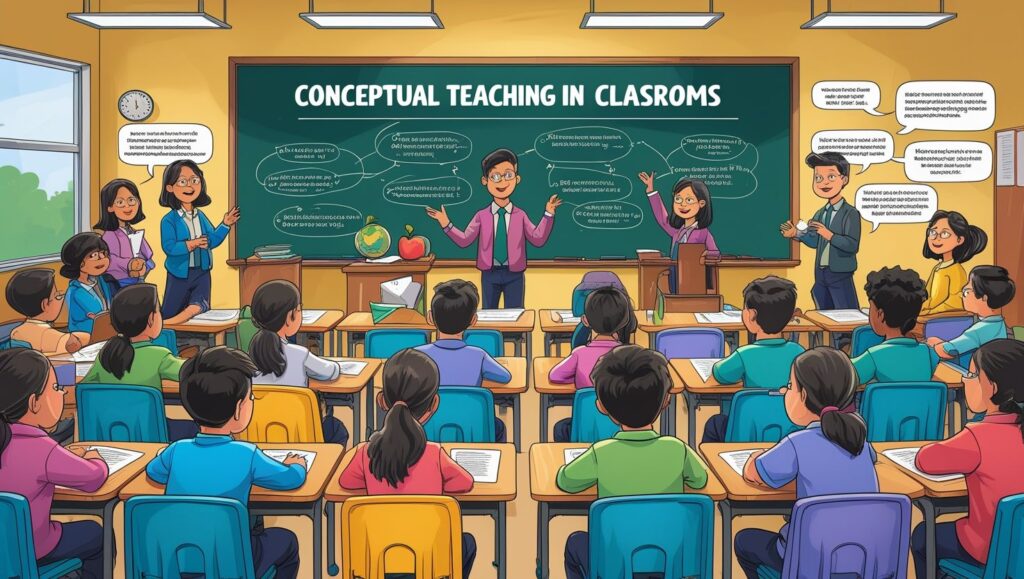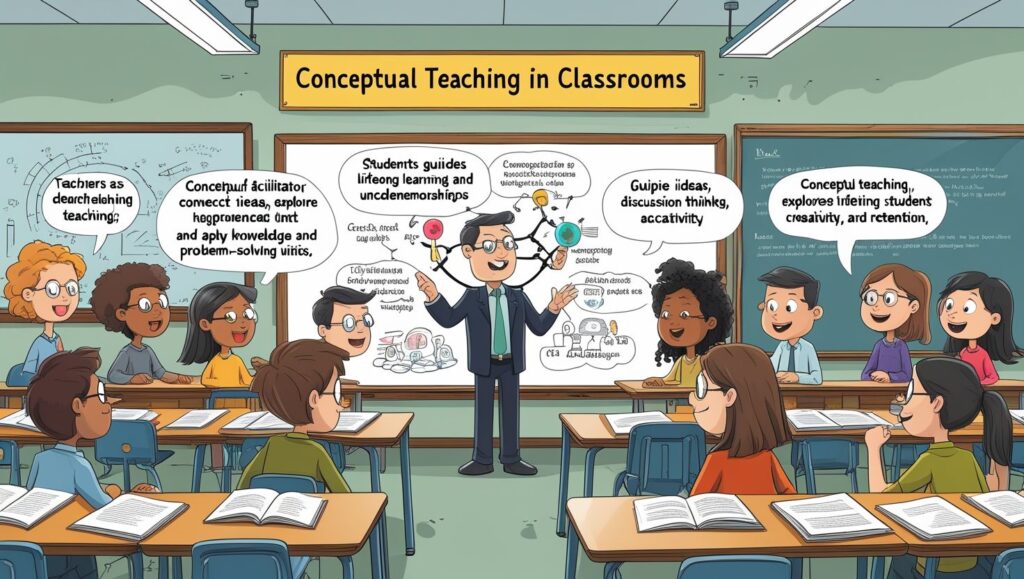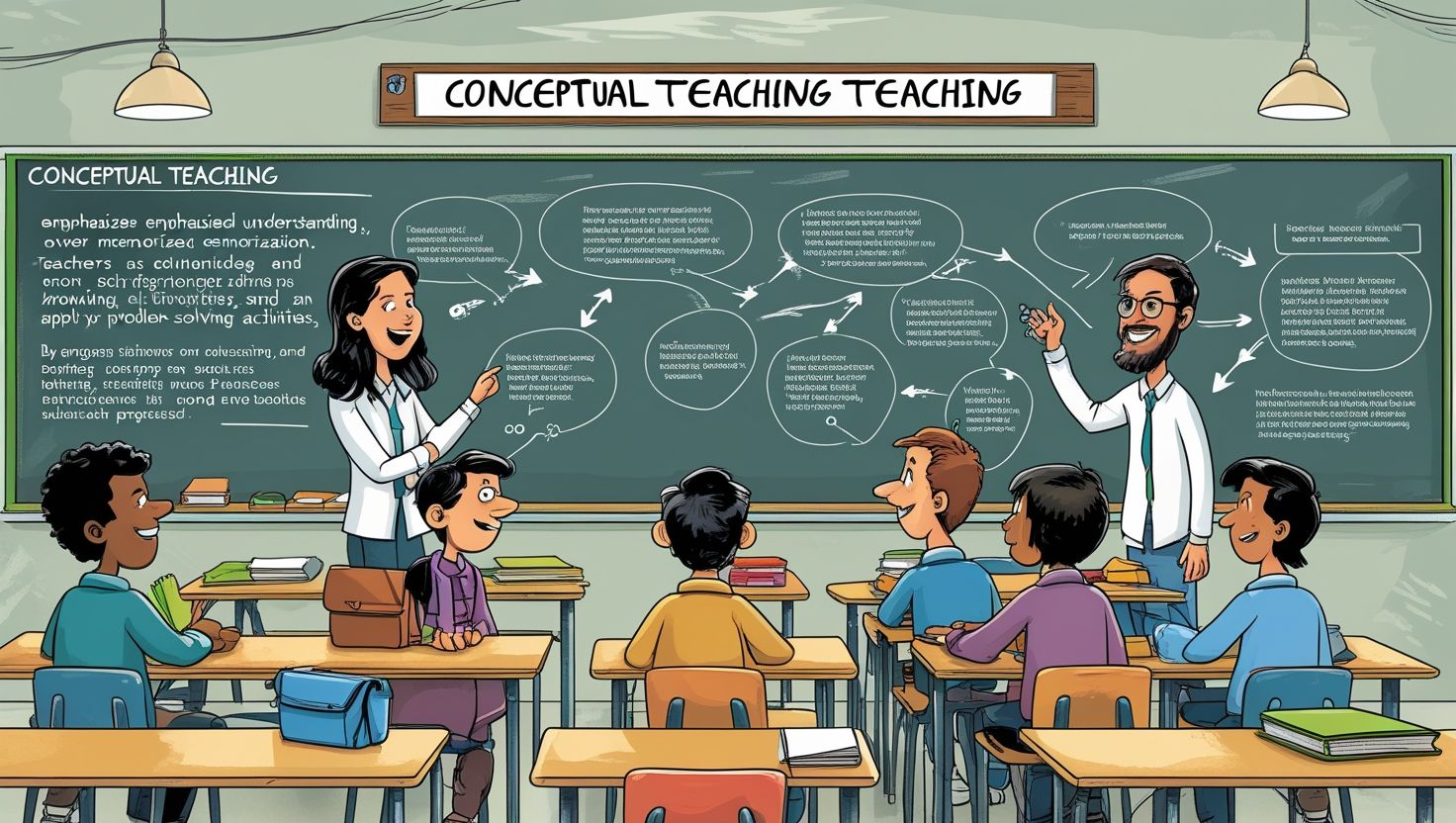Introduction
Conceptual teaching in classrooms focuses on developing deep understanding rather than surface-level memorization. In this approach, teachers encourage learners to connect ideas, recognize relationships, and see how knowledge applies across different situations. Unlike traditional teaching, which emphasizes rote learning, conceptual teaching allows students to grasp the “why” behind the “what.” It provides students with frameworks for problem-solving and critical thinking. Moreover, this method encourages active participation, questioning, and engagement. Teachers guide students to see how one concept links to another, which makes learning meaningful. For example, instead of memorizing formulas in mathematics, learners understand the concepts of patterns and relationships behind those formulas. Similarly, in social sciences, students learn to connect historical events with present realities. Therefore, conceptual teaching transforms classrooms into dynamic learning spaces where knowledge is not only acquired but also constructed meaningfully by students.
Importance of Conceptual Teaching in Education
The importance of conceptual teaching lies in its ability to prepare students for lifelong learning. While traditional methods can lead to short-term success in examinations, conceptual understanding equips learners with tools for long-term application. It helps students become independent thinkers who can analyze and solve new challenges effectively. Additionally, conceptual teaching fosters creativity because learners can apply knowledge to unfamiliar situations. For instance, when students understand scientific concepts, they can design experiments, make predictions, and test outcomes. Furthermore, conceptual learning improves retention since knowledge is stored in a meaningful structure within the brain. It also develops confidence because students no longer rely solely on memorization. Instead, they feel empowered to explain ideas in their own words. Moreover, this teaching style aligns with modern education standards that emphasize skills like critical thinking, problem-solving, and collaboration. Consequently, schools adopting this method create learners who are adaptable and competent in both academic and real-life contexts.

Principles of Conceptual Teaching
Conceptual teaching follows several principles that guide effective implementation in classrooms. First, teachers focus on big ideas rather than isolated facts. This allows learners to connect knowledge within and across subjects. Second, instruction encourages inquiry and questioning, which builds curiosity and deeper engagement. Third, students are given opportunities to apply concepts in real-life contexts, ensuring relevance. Fourth, learning is structured progressively, moving from simple to complex ideas while maintaining coherence. Moreover, collaboration is encouraged so learners can share diverse perspectives and refine understanding. Another principle is differentiation, where teaching methods are adapted to students’ needs and learning styles. Teachers also integrate reflection to help students evaluate their progress and build metacognition. Importantly, assessments are not limited to rote recall but measure conceptual understanding through projects, presentations, and discussions. These principles ensure that classrooms move beyond transmission of information toward meaningful construction of knowledge. As a result, students develop strong intellectual foundations for lifelong learning.
Role of Teachers in Conceptual Teaching
Teachers play a crucial role in making conceptual teaching effective. They act not only as instructors but also as facilitators who guide students in exploring and connecting ideas. A teacher designs activities that encourage critical thinking and collaboration. For example, in a science classroom, a teacher may encourage students to design experiments rather than only following instructions. Similarly, in mathematics, a teacher might use real-life examples to explain abstract concepts. Additionally, teachers provide scaffolding by giving appropriate support until learners can work independently. They also encourage open discussions where students can express and test their understanding. Moreover, teachers assess not just knowledge recall but also the depth of understanding. Another significant role is motivating students by showing the relevance of concepts to real-world situations. Furthermore, teachers create inclusive environments where all students, regardless of ability level, can engage meaningfully. Therefore, effective conceptual teaching depends largely on skilled, creative, and reflective teachers.
Student Engagement in Conceptual Learning
Student engagement is central to successful conceptual teaching. Learners must actively participate in constructing knowledge instead of passively receiving information. In conceptual classrooms, students ask questions, share ideas, and solve problems collaboratively. They take responsibility for their learning by making connections between concepts and applying them in meaningful contexts. Engagement also increases when teachers use real-world examples, technology, and interactive methods. For instance, using digital simulations or project-based learning makes concepts more relevant and exciting. Moreover, group discussions and debates encourage learners to think critically and consider multiple perspectives. Engagement is further enhanced when students are given choices in how they demonstrate understanding, such as through presentations, experiments, or creative projects. Importantly, engaged students show improved retention, motivation, and confidence. They develop a growth mindset, seeing challenges as opportunities for learning. Consequently, conceptual teaching creates classrooms where students are motivated to learn not because of exams but because they genuinely understand and value knowledge.
Strategies for Implementing Conceptual Teaching
Several strategies help teachers implement conceptual teaching effectively in classrooms. One strategy is using inquiry-based learning, where students explore questions and discover answers through guided research. Another is project-based learning, which allows students to work on meaningful tasks that require applying concepts. Teachers can also use concept maps to help learners visualize relationships between ideas. Additionally, case studies and real-life examples make abstract ideas concrete and relatable. Technology integration, such as digital simulations, interactive platforms, or multimedia resources, enhances engagement and understanding. Moreover, collaborative learning strategies, including group discussions and peer teaching, deepen comprehension. Differentiated instruction is another essential strategy because it meets diverse learning needs. Teachers should also use formative assessments like quizzes, reflections, and class discussions to check understanding continuously. Importantly, scaffolding ensures that learners move step by step toward mastery. By adopting these strategies, classrooms become active learning spaces where conceptual teaching thrives, promoting higher-order thinking and deeper understanding.

Challenges in Conceptual Teaching
Despite its many benefits, conceptual teaching faces several challenges in classrooms. One major challenge is resistance to change from traditional teaching practices. Many teachers and students are accustomed to rote learning and exam-focused instruction, which makes transition difficult. Another challenge is the limited training and resources available to teachers for adopting this approach. Large class sizes and rigid curricula also restrict opportunities for interactive and student-centered learning. Moreover, standardized testing systems often prioritize memorization over understanding, discouraging conceptual methods. Time constraints are another issue since conceptual teaching requires more discussions, projects, and activities. Additionally, diverse student abilities can make it difficult to implement strategies effectively without significant differentiation. Some students may also initially struggle with self-directed learning because they are not used to active engagement. Nevertheless, these challenges can be overcome with proper training, administrative support, and flexible teaching methods. Over time, consistent effort can make conceptual teaching a sustainable practice in schools.
Benefits of Conceptual Teaching for Lifelong Learning
Conceptual teaching offers long-term benefits that extend beyond classroom success. It equips students with transferable skills such as problem-solving, analytical thinking, and creativity. These skills are essential for adapting to the rapidly changing demands of the modern world. For instance, a student who learns concepts deeply can apply them in higher education, professional careers, and everyday life challenges. Additionally, conceptual understanding fosters curiosity and intrinsic motivation, leading to lifelong learning. Students become confident learners who seek knowledge independently rather than relying solely on teachers. Moreover, conceptual teaching improves collaboration and communication skills since students often work in groups and discuss ideas. It also enhances adaptability because learners can transfer understanding from one context to another. Importantly, lifelong learners are better prepared for professional development, innovation, and active participation in society. Therefore, conceptual teaching contributes not only to academic achievement but also to personal growth and lifelong success.
Conclusion
In conclusion, conceptual teaching in classrooms represents a shift from memorization to meaningful learning. It emphasizes understanding, connections, and real-world applications. Teachers serve as facilitators who guide learners in exploring, questioning, and applying knowledge. Students become active participants who engage deeply with concepts and develop critical skills. Despite challenges such as resistance, limited resources, and exam pressures, conceptual teaching remains essential for modern education. With proper strategies like inquiry-based learning, projects, and technology integration, classrooms can effectively adopt this method. The benefits are substantial, ranging from improved retention and creativity to the development of lifelong learning skills. Ultimately, conceptual teaching prepares students not just for examinations but for life, equipping them with the confidence and ability to navigate complex situations. By embracing this approach, educators ensure that learning is not only about acquiring facts but about building understanding that lasts a lifetime.

5fyp1a
I enjoy, result in I found just what I was having a look for.
You have ended my four day long hunt! God Bles you man. Have a great day.
Bye https://Fortune-glassi.mystrikingly.com/